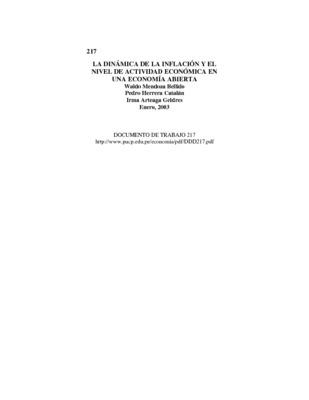| dc.contributor.author | Mendoza Bellido, Waldo Epifanio | |
| dc.contributor.author | Arteaga Geldres, Irma | |
| dc.contributor.author | Herrera Catalán, Pedro | |
| dc.date.accessioned | 2015-03-19T20:37:43Z | |
| dc.date.available | 2015-03-19T20:37:43Z | |
| dc.date.issued | 2003 | |
| dc.identifier.uri | http://repositorio.pucp.edu.pe/index/handle/123456789/46857 | |
| dc.description.abstract | En este trabajo presentamos un modelo similar al de Oferta y la Demanda Agregada, para el estudio de las fluctuaciones económicas de las dos variables macroeconómicas más importantes: la inflación y el nivel de actividad. En la primera parte presentamos el caso de una economía cerrada, en la cual se introducirán las ecuaciones básicas que describen el mercado de bienes, el mercado monetario, la curva de Phillips y los mecanismos de interacción entre ellas. Se presentará el modelo bajo el supuesto de expectativas adaptativas y expectativas racionales y veremos las trayectorias diferentes en la dinámica hacia el estado estacionario cuando la autoridad monetaria actúa bajo la Regla de Taylor. En la segunda parte se desarrollará el modelo para una economía abierta. Se introducirá la ecuación de paridad de las tasas de interés y se incorporará el tipo de cambio real como determinante del nivel de actividad económica. El objetivo de esta segunda parte será mostrar que la Regla de Taylor es una herramienta importante de política monetaria para estabilizar las fluctuaciones del nivel de actividad económica en una economía abierta. Se realizará el análisis con expectativas adaptativas y bajo dos escenarios: devaluación expansiva y devaluación recesiva. | es_ES |
| dc.description.abstract | In this paper we present a model similar to that of Aggregate Supply and Demand, for the study of the fluctuations of the two most important macroeconomic variables: inflation and the level of activity. In the first part we present the case of a closed economy, in which the basic equations will be introduced describing the market of goods, the monetary market, the curve of Phillips and the interaction mechanisms among them. The model will be presented under the assumption of adaptive expectations and rational expectations, and we will see the different trajectories in the dynamics toward the steady state when the monetary authority acts under the Rule of Taylor. In the second part we will develop the model for an open economy. The equation of parity of interest rates will be introduced, incorporating the real exchange rate as a determinant of the level of economic activity. The objective of this second part will be to show that the Rule of Taylor is an important monetary policy tool to stabilize the fluctuations of the level of economic activity in an open economy. We will carry out the analysis with adaptive expectations and under two scenarios: expansive devaluation and recessive devaluation. | en_US |
| dc.language.iso | spa | es_ES |
| dc.publisher | Pontificia Universidad Católica del Perú. Departamento de Economía | es_ES |
| dc.relation.ispartofseries | Documento de Trabajo;217 | es_ES |
| dc.rights | info:eu-repo/semantics/openAccess | es_ES |
| dc.rights.uri | http://creativecommons.org/licenses/by-nc-nd/2.5/pe/ | * |
| dc.subject | Inflación (Finanzas) | es_ES |
| dc.title | La dinámica de la inflación y el nivel de actividad económica en una economía abierta | es_ES |
| dc.title.alternative | The dynamics of inflation and the level of economic activity in an open economy. | en_US |
| dc.type | info:eu-repo/semantics/workingPaper | |
| dc.type.other | Documento de trabajo | |
| dc.subject.ocde | http://purl.org/pe-repo/ocde/ford#5.02.00 | |
| dc.publisher.country | PE | |
| renati.advisor.orcid | https://orcid.org/0000-0001-9422-7908 | |


